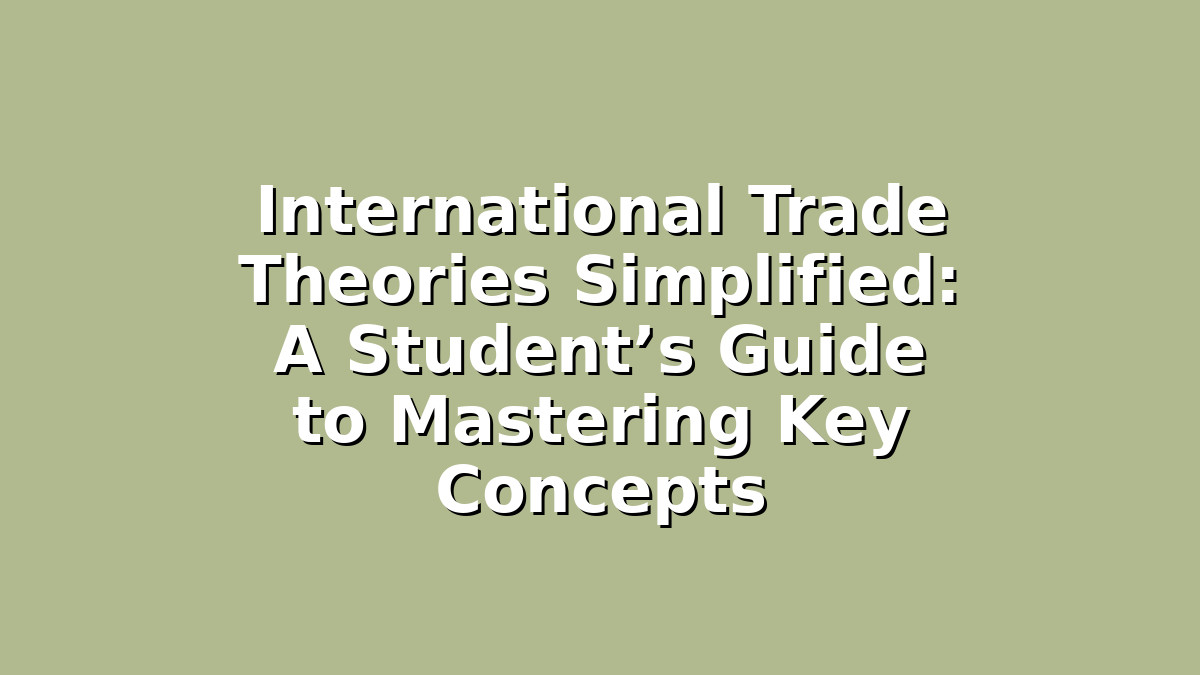International trade is a fascinating and essential topic for students studying economics, business, or social sciences. Understanding why countries trade, what goods and services they exchange, and how global trade benefits economies can sometimes feel daunting, especially when preparing for exams. This article aims to simplify the most important international trade theories, provide clear explanations, and offer practical study tips to help you succeed.
Introduction
For students, mastering international trade theories is crucial not only for exams but also for building a strong foundation in economics. These theories explain how and why countries engage in trade, the benefits of trading, and how trade impacts economic growth. However, the theories often come with complex terms and abstract ideas, which can be overwhelming. Don’t worry! By breaking down these theories into manageable parts and applying smart study strategies, you can grasp them confidently and perform well in your tests.
This guide covers three core trade theories — Absolute Advantage, Comparative Advantage, and Heckscher-Ohlin Theory — with explanations and study tips tailored specifically for exam preparation.
—
1. Absolute Advantage Theory: The Starting Point
What is Absolute Advantage?
One of the earliest trade theories was proposed by Adam Smith in the 18th century. Absolute advantage refers to a country’s ability to produce a good more efficiently than another country. If one country can produce more output using the same resources or the same output with fewer resources than another country, it has an absolute advantage.
Example:
Imagine Country A can produce 10 cars using 5 workers, while Country B can produce only 5 cars with the same number of workers. Country A has an absolute advantage in car production.
Why it matters:
This theory shows the basic idea that trade is beneficial when countries specialize in producing goods they can make more efficiently and trade for those they produce less efficiently.
Study Tips for Absolute Advantage:
– Create comparison charts: List countries on one side and products on the other. Note who produces more efficiently to visualize absolute advantage.
– Use real-world examples: Relate theory to familiar examples, such as comparing countries you know or goods like smartphones vs. agriculture products.
– Practice questions: Many exam questions ask you to identify absolute advantage based on production data. Practice with sample problems to get comfortable with calculations and interpretation.
– Flashcards: Use flashcards to memorize key definitions and terms related to absolute advantage for quick recall.
—
2. Comparative Advantage: The Heart of Trade Theory
What is Comparative Advantage?
Developed by David Ricardo, this theory expands on absolute advantage by focusing on opportunity costs. Comparative advantage occurs when a country can produce a good at a lower opportunity cost compared to other countries, even if it does not have an absolute advantage.
Why it’s important:
This theory explains why countries benefit from trade by specializing in goods they produce relatively more efficiently, leading to increased overall economic welfare.
Example:
Suppose Country A can produce either 10 cars or 5 computers, and Country B can produce 6 cars or 6 computers. Even if Country A produces both goods more efficiently, it is better for Country A to specialize in cars (lower opportunity cost) and Country B to specialize in computers.
Study Tips for Comparative Advantage:
– Master opportunity cost calculation: Understand how to calculate opportunity cost as it’s fundamental to this theory. Practice with different numerical problems.
– Diagram practice: Draw simple production possibility frontiers (PPFs) to visualize opportunity costs and gains from trade.
– Relate to exam scenarios: Many questions involve choosing which country should specialize in what. Practice identifying comparative advantages from given data sets.
– Teach someone else: Explaining the concept to a peer can help reinforce your understanding and uncover any gaps.
—
3. Heckscher-Ohlin Theory: Factor Endowments and Trade
What is Heckscher-Ohlin Theory?
Also known as the factor-proportions theory, this model explains trade patterns based on countries’ factor endowments—namely labor, capital, and land. The idea is that countries export goods that use their abundant and cheap factors of production intensively and import goods that use their scarce factors intensively.
Why it matters:
This theory offers a more detailed explanation of trade than absolute or comparative advantage, considering capital and labor differences across countries.
Example:
A country with abundant capital and less labor (like a developed economy) tends to export capital-intensive goods like machinery, while a labor-rich country exports labor-intensive goods such as textiles.
Study Tips for Heckscher-Ohlin:
– Understand factor endowments: Focus on the key factors—labor, capital, land—and what it means for a country to be abundant or scarce in these.
– Use tables and charts: Create charts showing countries’ factor endowments and corresponding exports/imports to help visualize concepts.
– Review case studies: Many exam questions include real-world examples or ask for interpretations based on this theory. Reviewing case studies helps contextualize the theory.
– Summarize the theory: Write concise summaries or bullet points explaining how factor endowments influence trade patterns, which can be handy for quick revision.
—
Conclusion
International trade theories provide the foundation for understanding global economic interactions. While the terminology and abstract ideas can seem challenging, breaking down each theory into simple parts and using practical study techniques can make mastering them achievable and even enjoyable. Remember to practice frequently, use visuals like charts and diagrams, and apply real-world examples to deepen your understanding.
Stay consistent with your studies, and don’t hesitate to discuss difficult concepts with classmates or teachers. With effort and the right strategies, you’ll not only excel in your exams but also build a solid knowledge base for future economic studies.
Good luck with your preparations—international trade theories are within your grasp!

Responses